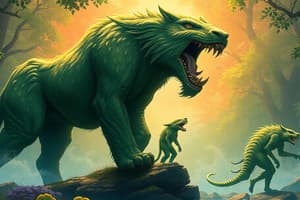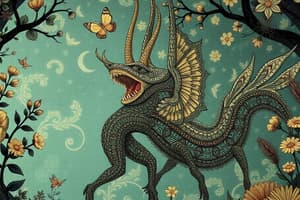Podcast
Questions and Answers
A population of birds experiences a prolonged drought, leading to a scarcity of small seeds. Birds with larger beaks are better able to crack open the remaining larger seeds. What is the most likely outcome after several generations?
A population of birds experiences a prolonged drought, leading to a scarcity of small seeds. Birds with larger beaks are better able to crack open the remaining larger seeds. What is the most likely outcome after several generations?
- The bird population will exhibit increased variation in beak size due to the diverse food sources available.
- The average beak size in the bird population will decrease as smaller-beaked birds adapt to consuming insects.
- The average beak size in the bird population will increase due to the higher survival rate of birds with larger beaks. (correct)
- The bird population will maintain a constant beak size distribution, as the drought equally affects all individuals.
Farmers selectively breed their livestock to produce animals with more muscle mass. What is a potential long-term consequence of this practice on the livestock population?
Farmers selectively breed their livestock to produce animals with more muscle mass. What is a potential long-term consequence of this practice on the livestock population?
- Enhanced adaptation to a wide range of environmental conditions due to the introduction of new genes.
- A reduction in the frequency of desirable traits due to random mating.
- Increased genetic diversity within the livestock population, enhancing their resilience to diseases.
- Decreased genetic diversity and potential increased susceptibility to diseases or environmental changes. (correct)
A plant species exhibits variation in its flowering time. Some plants flower early in the season, while others flower later. If climate change leads to warmer temperatures earlier in the year, what is the likely long-term effect on the plant population's flowering time?
A plant species exhibits variation in its flowering time. Some plants flower early in the season, while others flower later. If climate change leads to warmer temperatures earlier in the year, what is the likely long-term effect on the plant population's flowering time?
- The plant population will likely shift towards later flowering times to avoid frost damage.
- The plant population will likely maintain its original flowering time distribution due to genetic constraints.
- The plant population will likely experience a decrease in overall flowering due to disrupted pollination patterns.
- The plant population will likely shift towards earlier flowering times as individuals that flower earlier have a higher reproductive success. (correct)
A butterfly population exhibits two distinct color patterns: bright orange and dark brown. Birds prey on the butterflies, and the bright orange butterflies are easier for the birds to spot. Over time, what is the likely outcome for the butterfly population?
A butterfly population exhibits two distinct color patterns: bright orange and dark brown. Birds prey on the butterflies, and the bright orange butterflies are easier for the birds to spot. Over time, what is the likely outcome for the butterfly population?
What is the primary rationale behind extracting DNA from human cells and using restriction enzymes in the production of genetically modified (GM) bacteria for insulin?
What is the primary rationale behind extracting DNA from human cells and using restriction enzymes in the production of genetically modified (GM) bacteria for insulin?
Which of the following best describes the role of DNA ligase in the production of GM bacteria for insulin?
Which of the following best describes the role of DNA ligase in the production of GM bacteria for insulin?
Why are recombinant plasmids containing the insulin gene added to a bacterial culture?
Why are recombinant plasmids containing the insulin gene added to a bacterial culture?
What distinguishes artificial selection from natural selection?
What distinguishes artificial selection from natural selection?
Which of the following is a potential concern associated with the use of genetically modified (GM) pest-resistant crops?
Which of the following is a potential concern associated with the use of genetically modified (GM) pest-resistant crops?
Which of the following processes is most directly involved in adaptation?
Which of the following processes is most directly involved in adaptation?
What is a direct consequence of overproduction in a population when resources are limited?
What is a direct consequence of overproduction in a population when resources are limited?
How do variations within a population contribute to the process of natural selection?
How do variations within a population contribute to the process of natural selection?
What is a likely outcome when a population's environment changes rapidly, and the population lacks sufficient variation to adapt?
What is a likely outcome when a population's environment changes rapidly, and the population lacks sufficient variation to adapt?
What is the purpose of cutting both the human DNA and the plasmid with the same restriction enzyme?
What is the purpose of cutting both the human DNA and the plasmid with the same restriction enzyme?
A population of insects is exposed to a new pesticide. Initially, most insects are susceptible, but over time, a significant portion of the population becomes resistant. What mechanism best explains this?
A population of insects is exposed to a new pesticide. Initially, most insects are susceptible, but over time, a significant portion of the population becomes resistant. What mechanism best explains this?
Which of the following is a potential ecological risk associated with herbicide-resistant genetically modified crops?
Which of the following is a potential ecological risk associated with herbicide-resistant genetically modified crops?
Which of the following correctly orders the steps in producing bacteria that are genetically modified to produce insulin?
Which of the following correctly orders the steps in producing bacteria that are genetically modified to produce insulin?
A population of fish lives in a lake. Some fish are naturally larger than others. If the lake's water level decreases significantly due to a drought, and only the larger fish can reach the remaining food sources, what type of selection is most likely to occur?
A population of fish lives in a lake. Some fish are naturally larger than others. If the lake's water level decreases significantly due to a drought, and only the larger fish can reach the remaining food sources, what type of selection is most likely to occur?
In a stabilizing selection scenario, which individuals in a population are most likely to have a higher fitness?
In a stabilizing selection scenario, which individuals in a population are most likely to have a higher fitness?
Golden rice has been genetically modified to produce a precursor of which vitamin in its edible parts?
Golden rice has been genetically modified to produce a precursor of which vitamin in its edible parts?
Flashcards
Adaptation
Adaptation
The process by which populations become better suited to their environment over many generations.
Variations
Variations
Differences occurring among individuals of a population; some improve fitness, others reduce it.
Overproduction
Overproduction
Producing more offspring than the environment can sustain, leading to competition.
Survival advantage
Survival advantage
Signup and view all the flashcards
Stabilizing selection
Stabilizing selection
Signup and view all the flashcards
Artificial selection
Artificial selection
Signup and view all the flashcards
Genetic engineering
Genetic engineering
Signup and view all the flashcards
Genetically modified (GM) plants
Genetically modified (GM) plants
Signup and view all the flashcards
Restriction enzyme
Restriction enzyme
Signup and view all the flashcards
Plasmid
Plasmid
Signup and view all the flashcards
DNA ligase
DNA ligase
Signup and view all the flashcards
Recombinant plasmid
Recombinant plasmid
Signup and view all the flashcards
Study Notes
- Adaptation is how populations become better suited to their environment over generations.
- Variations among individuals can make some more fit and others less fit to their environment.
- Overproduction occurs when a population produces more offspring than the environment can support.
- Limited resources cause organisms to compete and struggle to survive.
- Individuals with advantageous traits are more likely to survive than those lacking such traits.
- Over time, traits that enhance survival become more common, while less advantageous traits decrease or disappear.
- Stabilizing selection favors the most common phenotype and selects against less common ones.
- Artificial selection involves humans selecting organisms with desired traits to breed, increasing the chance of those traits appearing in the next generation. Also known as selective breeding.
- Artificial selection is a result of human intervention, while natural selection occurs spontaneously.
- Characteristics chosen during artificial selection may not necessarily improve an organism's adaptation to its natural environment.
Genetic Engineering
- Genetic engineering involves altering an organism's genetic material by removing, changing, or inserting genes.
- Most insulin for type I diabetes treatment is produced by genetically engineered bacteria containing the human gene for insulin.
- Genetic engineering is used in agriculture to create genetically modified (GM) plants with traits like herbicide and pest resistance.
- Some rice varieties have been genetically modified to produce vitamin A precursors in their edible parts.
- There are concerns that herbicide-resistance genes from modified crops could create herbicide-resistant weeds ("superweeds").
- Concerns exist regarding the potential health effects of consuming GM crops.
- Using pest-resistant crops raises concerns about harm to beneficial insects and the development of resistant pests.
- To produce GM bacteria with the insulin gene, DNA is extracted from human cells and cut into fragments using a restriction enzyme.
- DNA fragments containing the insulin gene are identified and selected.
- Plasmids and human DNA are cut with the same restriction enzyme.
- Human DNA fragments with the insulin gene are bound to cut plasmids using DNA ligase.
- Recombinant plasmids containing the insulin gene are added to a bacterial culture.
- Bacteria that take up the plasmids are selected and grown to create recombinant bacteria which produce insulin, the insulin is then extracted and purified.
Studying That Suits You
Use AI to generate personalized quizzes and flashcards to suit your learning preferences.




